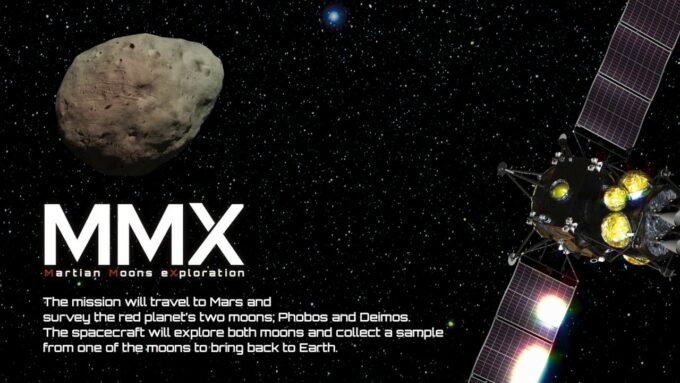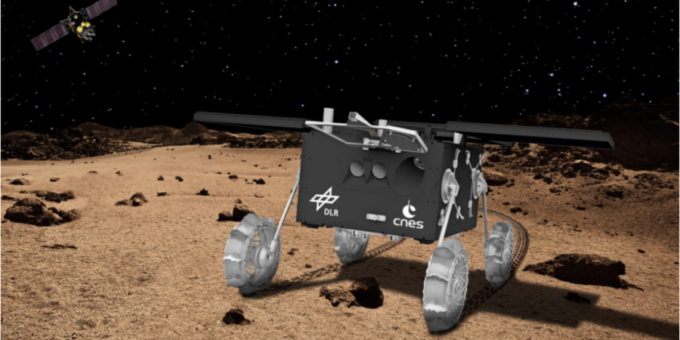Anywaves’ Antennas Key Role in the MMX Mars Moons Exploration
The Martian Moons Exploration (MMX) project, led by the Japan Aerospace Exploration Agency (JAXA) in collaboration with the French space agency CNES, aims to study Mars’ largest moon, Phobos. The mission’s primary objectives are to explore the moon, gather samples, and return them to Earth for analysis. This initiative seeks to deepen our understanding of the Martian environment, the origins of Mars’ moons, and the solar system’s early days. Anywaves is significantly contributing to this mission by providing S-Band TT&C antennas, essential for ensuring robust communication between the rover and the orbiter.
Let’s explore together the MMX mission’s goals, the innovative technologies being used, the progress made so far, and the next steps leading up to the 2026 launch.

Source: Futura Science
MMX Project Overview
The Martian Moons Exploration (MMX) mission is a groundbreaking endeavor spearheaded by the Japan Aerospace Exploration Agency (JAXA) in collaboration with the French space agency CNES, and other international partners. Its primary objective is to explore Mars’ largest moon, Phobos, to unravel the mysteries surrounding the Martian environment, the origins of Mars’ moons, and by extension, insights into the early solar system. This could involve determining whether these moons are captured asteroids or were formed from debris resulting from a giant impact on Mars, similar to the theory of the Moon’s formation around Earth.
This mission stands out not just for its ambitious goals but also for its comprehensive approach to space exploration, combining orbiting, landing, and sample return technologies in one mission.
Objectives and Goals
The mission’s goals are multi-faceted, aiming to shed light on several key scientific questions:
- Origin of Mars’ Moons: By analyzing the surface and subsurface samples from Phobos, MMX seeks to determine whether Mars’ moons are captured asteroids or the result of a massive impact event. This has significant implications for understanding planetary formation and evolution processes.
- Martian Environment Insight: The mission will study the surface and dust environment of Phobos, contributing valuable data on the Martian atmosphere, weather patterns, and surface composition.
- Technology Demonstration: MMX will also serve as a platform for testing advanced space exploration technologies, including autonomous navigation, surface sampling mechanisms, and the safe return of extraterrestrial samples to Earth.
The MMX mission’s success could provide unprecedented insights into the origins and evolution of Mars and its moons, contributing to a broader understanding of planetary formation and the conditions conducive to life. Through the analysis of samples collected from Phobos, scientists hope to determine the most likely theory for the moons’ formation, whether through capture or coalescence post a giant impact. Additionally, by observing Mars and its space environment from the vicinity of its moons, the mission may explore mechanisms for atmospheric material circulation and climate change on Mars.
Mission Architecture
The MMX mission is designed with a sophisticated mission architecture that includes:
- Orbiter Module: Equipped with scientific instruments to study Phobos from orbit, including cameras, spectrometers, and radars to map the moon’s surface composition and topography.
- Lander and Rover: The mission will deploy a lander to the surface of Phobos, which will release the rover, Idefix, developed by CNES. This rover is tasked with conducting in-situ analysis while the lander will collect samples from the moon’s surface.
- Sample Return: One of the mission’s most ambitious aspects is the collection of surface and possibly subsurface samples to be returned to Earth for comprehensive analysis. This requires precise landing, sample collection, and a complex return trajectory to safely bring the samples back to our planet.
Timeline and Phases
The MMX mission is scheduled for launch in November 2026, with a journey to Mars that will take several months. Upon arrival, it will enter a Quasi-Stationary Orbit (QSO) around Phobos. The orbiter will spend time mapping Phobos and selecting a suitable landing site. The lander, carrying the rover, will then descend to the moon’s surface, marking a significant milestone in the mission. The surface operations phase, involving the rover’s exploration and sample collection, is expected to last several weeks to months, depending on the mission’s progress and findings. Following the completion of its objectives, the mission will prepare for the return journey to Earth, with the samples anticipated to arrive in early 2030.
Scientific and Technological Innovations
The MMX mission is poised to advance our scientific and technological capabilities significantly. Scientifically, it seeks to clarify the evolution process of the Martian sphere (Mars, Phobos, Deimos) and the origin of its moons. Technologically, the mission aims to establish the necessary technologies for a return trip between Earth and Mars, develop advanced sampling techniques for celestial bodies, and refine optimal communication technologies using a newly developed ground station
A key feature of the MMX mission is its innovative sampling methodology. The mission’s sampler is equipped with two sampling methods: the Coring Sampler (C-SMP) for collecting regolith from depths greater than 2 cm and the Pneumatic Sampler (P-SMP) for surface samples. These techniques allow for the rapid collection of samples, which is critical given the scheduled sampling procedure is to be completed in just 2.5 hours
Focus on the MMX Rover: A Technological Marvel on Phobos
The Martian Moons Exploration (MMX) mission is equipped with a sophisticated rover designed to traverse the landscapes of Phobos. This rover, proudly named Idefix, is a joint development between the French space agency CNES and the German Aerospace Center (DLR). It represents a significant leap in space exploration technology and scientific inquiry.
Autonomous Operation and Scientific Missions
Weighing less than 30 kilograms, the MMX rover is tasked with conducting in-situ scientific measurements that are pivotal for understanding the surface and subsurface composition of Phobos. The rover’s autonomy is crucial, as it must operate under the challenging conditions of Phobos’ surface, far from direct intervention from Earth. Upon its deployment in 2026, the rover will autonomously right itself and commence its mission, showcasing advanced robotics and autonomous navigation technologies.
Innovative Instrumentation and Risk Reduction
The rover’s suite of scientific instruments includes cameras supplied by CNES, designed to study the interaction between the rover’s wheels and the regolith, as well as for stereo-navigation. Additionally, it is equipped with a Raman spectrometer and a radiometer developed by DLR, tools that are essential for conducting detailed scientific analyses directly on Phobos’ surface. These instruments not only serve to gather unprecedented data but also to assess the feasibility of landing and sample collection sites by studying the local gravity and potential contamination from external elements.
Technological Demonstrator for Low-Gravity Locomotion
Perhaps one of the most significant aspects of the MMX rover is its role as a technological demonstrator for mobility in microgravity conditions. Phobos’ gravity, only a fraction of Earth’s, presents unique challenges for locomotion and navigation. The rover will test various algorithms for hazard avoidance and autonomous travel, potentially setting new standards for future exploration missions in similar low-gravity environments.
Pioneering Communication: The Role of Anywaves’ Antennas
Crucial to the MMX rover’s success is its communication system, designed to establish a robust link with the orbiter via an intersatellite link (ISL) utilizing dedicated S-Band equipment.
This is where Anywaves steps in with its cutting-edge S-Band TT&C antennas. Designed to ensure seamless communication, our antennas are set to be placed on both the rover and the orbiter, providing critical links for data transmission throughout the mission
Design Excellence and Technological Innovation
The S-Band TT&C antennas by Anywaves stand out due to their compact design, robustness, and high efficiency, characteristics that are essential for deep-space missions. The choice of the S-Band frequency for telemetry, tracking, and command (TT&C) operations is strategic, offering an optimal balance between data rate capabilities and the ability to operate under various space conditions, including the Martian moons’ unique environment. These antennas are engineered to withstand the harsh conditions of space travel, from extreme temperature variations to radiation, ensuring reliable operation throughout the mission’s duration.

Anywaves Antenna on the MMX Rover
How It’s Going: Progress and Next Steps
As excitement builds toward the 2026 launch, Anywaves, along with our partners at JAXA and CNES, is deeply engaged in the preparation and testing phases to ensure that every component of the mission meets the highest standards of reliability and performance. The development of Idefix, the rover, is progressing well, with Toulouse playing a pivotal role in its finalization. The integration of our S-Band TT&C antennas into the mission’s equipment is a critical step that is currently underway, with rigorous testing to follow to guarantee that they can withstand the harsh conditions of space and the Martian environment.
Conclusion
The Martian Moons Exploration (MMX) mission represents a significant leap in interplanetary exploration, driven by a collaborative international effort. With its sophisticated mission architecture, advanced technological solutions, and ambitious scientific objectives, MMX stands to deepen our understanding of the solar system’s evolution and the intricate processes that have shaped the planets and their moons.
Anywaves is immensely proud to be a part of this project. Contributing our advanced S-Band TT&C antennas to this mission underlines our commitment to supporting space exploration and highlights the critical role of reliable communication in the success of such complex missions.
As we count down to the launch in 2026, our focus remains on ensuring the success of our contribution to the mission and the anticipation of the invaluable insights that the exploration of Phobos will bring.
Contact
us
If you have any question, we would be happy to help you out.



